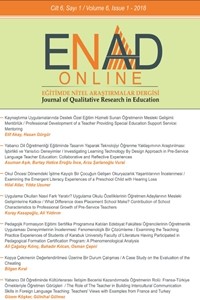The Role of The Teacher in Building Intercultural Communication Skills in Foreign Language Teaching: Teachers’ Views with Examples from France and Turkey
Öz
Globalization and communication technologies are making intercultural communication necessary in international platform. Individuals need some skills to communicate effectively. Current foreign language teaching programs need to be prepared with the practices aimed at building intercultural communication skills. As in every educational process, the teacher is the most responsible person in teaching these skills. To identify and compare views of foreign language teachers on the teacher's role in building intercultural communication skills in foreign language teaching, and to collect data, twenty teachers from two universities of France and Turkey were asked to complete an open-ended questionnaire and followed one by one interview. The ethnic and cultural diversity enabled us to make comparisons among different perspectives. The analysis revealed that all participants developed awareness about importance of intercultural communication, yet experienced difficulties in planning intercultural activities and covering them in actual lessons. It was revealed that none of the participants had received any special training on intercultural communication. Some different views of participants that emerged, as a result of this study, are attributed to their cultural codes.
Anahtar Kelimeler
Foreign language teaching intercultural communication skills the role of the teacher
Kaynakça
- Abdallah-Pretceille, M. (2013). L’éducation interculturelle. 4ème édition. Paris: Puf.
- Baumgratz-Gangl, G. (1993). Compétence transculturelle et échanges éducatifs. Paris: Hachette.
- Bennett, J.M. et Bennett, M.J. (2004). Developping Intercultural Sensitivity: An Intagrative Approach to Global and Domestic diversity. Dans Landis D., Bennett J.M. et
- Bennett M.J. (Eds). Handbook of Intercultural Training (147-165). 3ème edition. Thousand Oaks, CA: SAGE.
- Byram M. (1992). Culture et éducation en langue étrangère. LAL, Crédif. Hatier/ Didier.Paris.
- Carpentier C., Riard E.H. (2010). Vivre ensemble et éducation dans les sociétés multiculturelles. L’Harmattan. Paris.
- Conseil de l’Europe. (2000). CECR. Un cadre européen commun de référence pour les langues. Apprendre, enseigner, évaluer. Strasbourg. Retrieved from http://www.coe.int/t/dg4/linguistic/Source/Framework_FR.pdf
- Collès, L. (2013). Passage des frontières. Études de didactique du français et de l'interculturel. Presses Universitaires de Louvain.
- Creswell, J.W. (2007). Qualitative inquiry and research design. 2nd edition. Thousand Oaks, CA : Sage.
- De Carlo, M. (1998). L’Interculturel. Paris : Clé International.
- Dumez, H. (2013). Méthodologie de la recherche qualitative – Les 10 questions clés de la démarche compréhensive. Paris : Vuibert.
- Girardet, J. (2011). Enseigner le FLE selon une approche actionnelle : quelques propositions méthodologiques. In Conférence. Actes du XIIème colloque pédagogique de l’Alliance française de Sao Paolo. Brasil : Aliança Francesa São Paulo. Retrieved fromhttp://www.vintage-language.fr/ressources/acte_conference_jacky_girardet.pdf
- Puren, C. (2006). De l’approche communicative à la perspective actionnelle. Le Français dans le monde, 347, 37-40.
- Windmüller, F. (2011). Français langue étrangère (FLE): l’approche culturelle et interculturelle. Paris : Belin.
- Yıldırım, A., & Şimşek, H. (2005). Sosyal bilimlerde nitel araştırma yöntemleri. Ankara: Seçkin Yayıncılık.
- Zarate, G. (1993). Représentations de l'étranger et didactique des langues. Paris: Didier.
Öz
Kaynakça
- Abdallah-Pretceille, M. (2013). L’éducation interculturelle. 4ème édition. Paris: Puf.
- Baumgratz-Gangl, G. (1993). Compétence transculturelle et échanges éducatifs. Paris: Hachette.
- Bennett, J.M. et Bennett, M.J. (2004). Developping Intercultural Sensitivity: An Intagrative Approach to Global and Domestic diversity. Dans Landis D., Bennett J.M. et
- Bennett M.J. (Eds). Handbook of Intercultural Training (147-165). 3ème edition. Thousand Oaks, CA: SAGE.
- Byram M. (1992). Culture et éducation en langue étrangère. LAL, Crédif. Hatier/ Didier.Paris.
- Carpentier C., Riard E.H. (2010). Vivre ensemble et éducation dans les sociétés multiculturelles. L’Harmattan. Paris.
- Conseil de l’Europe. (2000). CECR. Un cadre européen commun de référence pour les langues. Apprendre, enseigner, évaluer. Strasbourg. Retrieved from http://www.coe.int/t/dg4/linguistic/Source/Framework_FR.pdf
- Collès, L. (2013). Passage des frontières. Études de didactique du français et de l'interculturel. Presses Universitaires de Louvain.
- Creswell, J.W. (2007). Qualitative inquiry and research design. 2nd edition. Thousand Oaks, CA : Sage.
- De Carlo, M. (1998). L’Interculturel. Paris : Clé International.
- Dumez, H. (2013). Méthodologie de la recherche qualitative – Les 10 questions clés de la démarche compréhensive. Paris : Vuibert.
- Girardet, J. (2011). Enseigner le FLE selon une approche actionnelle : quelques propositions méthodologiques. In Conférence. Actes du XIIème colloque pédagogique de l’Alliance française de Sao Paolo. Brasil : Aliança Francesa São Paulo. Retrieved fromhttp://www.vintage-language.fr/ressources/acte_conference_jacky_girardet.pdf
- Puren, C. (2006). De l’approche communicative à la perspective actionnelle. Le Français dans le monde, 347, 37-40.
- Windmüller, F. (2011). Français langue étrangère (FLE): l’approche culturelle et interculturelle. Paris : Belin.
- Yıldırım, A., & Şimşek, H. (2005). Sosyal bilimlerde nitel araştırma yöntemleri. Ankara: Seçkin Yayıncılık.
- Zarate, G. (1993). Représentations de l'étranger et didactique des langues. Paris: Didier.
Ayrıntılar
| Birincil Dil | Türkçe |
|---|---|
| Bölüm | Makaleler |
| Yazarlar | |
| Yayımlanma Tarihi | 31 Mart 2018 |
| Yayımlandığı Sayı | Yıl 2018 Cilt: 6 Sayı: 1 |


